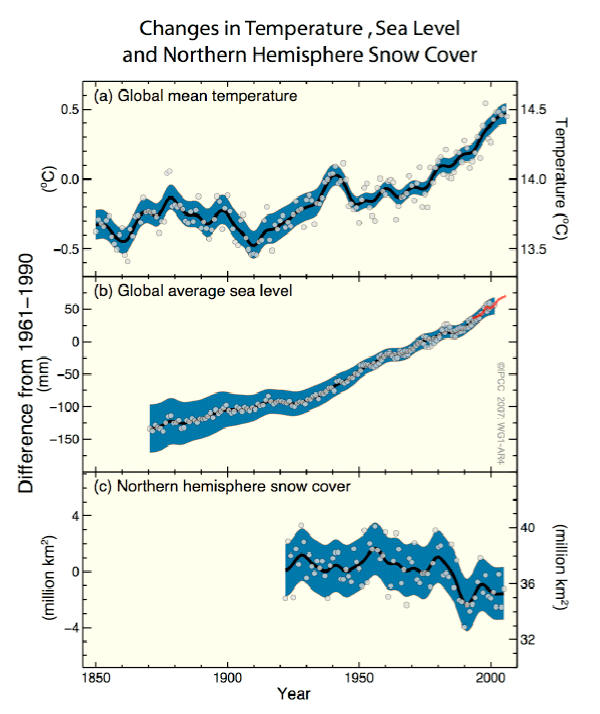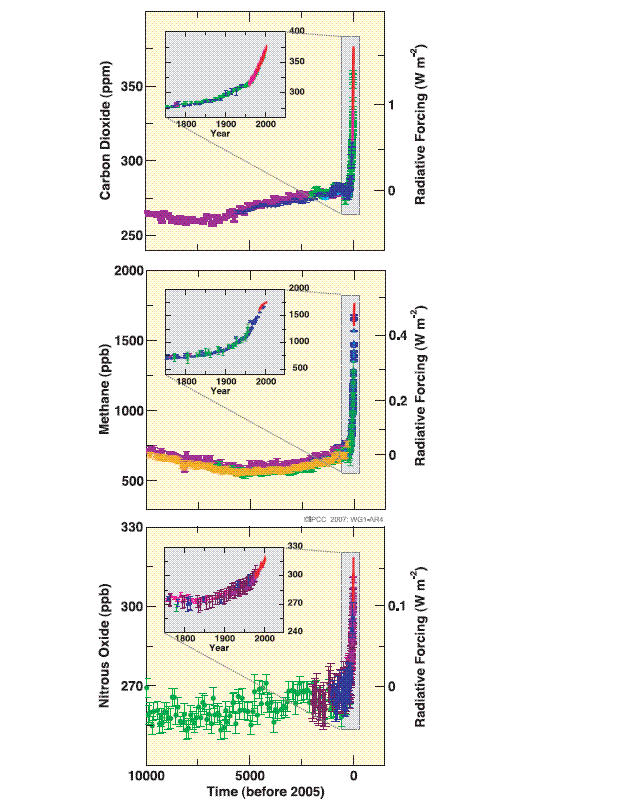Global Warming & Climate Change
The Earth's global average climate is determined by incoming radiation (energy) from the Sun and by the properties of the atmosphere-earth interactions, like reflection, emission and absorption. Changes in the Earth's global average climate can be attributed to both natural and human (anthropogenic) drivers. Many studies conducted with respect to climate change validate its current manifestation. Natural factors like the Sun's intensity and volcanic explosions do play a role. Notwithstanding these natural causes, it is extremely likely (95% confidence level) that human activities have exerted a substantial net warming influence on the climate since 1750, as reported in the Intergovernmental Panel on Climate Change (IPCC) Fourth Assessment report (AR4, published in 2007).
The IPCC is a forum founded in 1988 by the World Meteorological Organization (WMO, an agency of the United Nations) and the United Nations Environmental Program (UNEP) with the objective of formulating an unbiased point of view with respect to global warming and climate change on a global scale. Since the institution of the IPCC many scientific articles, methods, reports, and other products have been published, creating a framework for policy makers and scientists.
Findings of the IPCC
Surface observations conducted during the last centuries indicate that the average air temperature over both the sea and land surface has been increasing since 1861 with a an increase equal to 0.74 ± 0.9°C. Satellite observations moreover indicate a decrease of 3.3% of the ice sheets during the last decades. This decrease in these ice sheets has resulted in an increase of the mean sea level (MSL) between 12 and 22 cm. Furthermore it can be assumed with great certainty that the rainfall in different countries has increased significantly during the twentieth century. The El Niño, i.e the warm episode of the El Niño Southern Oscillation (ENSO), which causes extreme drought and extreme precipitation events, has become more frequent compared to the preceding 100 years. In addition the panel concluded that an increase in the tropical cyclone activity over the Atlantic ocean and in less extent also in the other regions. However the multidecedal cycle of the Atlantic ocean, the effects of the ENSO on the formation of tropical cyclones, together with the lack of reliable data before 1970 makes it difficult to attribute this increase to climate change.

Fig 1. Observed changes in (a) global average surface temperature, (b)global average sea level from tide gauge data and (c) Northern Hemisphere snow cover for March-April. All changes are relative to corresponding averages for the base period 1961 to 1990.The smoothed curves show the decadal average values and the circles show yearly values. The shaded areas represent the uncertainty intervals. (Source:Working group I: The physical science basis, IPCC 4th Assessment Report.) |

Fig 2. Atmospheric concentrations of carbon dioxide, methane and nitrous oxide (greenhouse gases) over the last 10,000 years (large panels) and since 1750 (inset panels). This data is derived from measurements from ice cores conducted during differnt studies (indicated by the different symbol colors). The corresponding radiative forcings are shown on the right hand axes of the large panels.(Source:Working group I: The physical science basis, IPCC 4th Assessment Report.) |
The climate system and the cause of climate change
The earth's climate is determined by complex interactions between the Sun, oceans, atmosphere, cryosphere, land surface and biosphere. These interactions are governed by physical laws like conservation of mass, energy and Newton's second law of motion. Sunlight comprising of both short and long wavelength is radiated by the Sun towards the Earth. This energy is distributed unevenly over the Earth's surface due to the tilt (about 23 ° from true north) of the Earth's axis of rotation. The Earth' surface absorbs (about 49% of the sun's total radiation) short wavelength radiation in the form of warmth and reflects about 9% of this energy back to space. In the atmosphere about 20% of the solar radiation is absorbed by clouds, gases and aerosols (small particles like for example dust), whereas 22% is reflected back to space. The Earth on the other hand radiates the absorbed radiation in the form of long wave radiation back to the atmosphere, where the atmospheric greenhouse gases absorb about 40% of the Earth's long wave radiation. These interaction, i.e.the natural greenhouse effect, result in the warming of the air temperature near the Earth's surface, to its average temperature of 18 °C. This temperature is about 33 °C higher than would be achieved by solar radiation alone. Changes in the composition of the gases in the atmosphere, change the intensity of the natural greenhouse effect. These changes in composition of the greenhouse gases can occur as a result of both internal variability within the climate system and external factors, both natural
(for example the 22 year cycle of the solar activity, which causes fluctuation in the solar intensity) and anthropogenic.
The anthropogenic factors have become visible with the increase of Carbon Oxide (CO2) gas due to the burning of fossil fuel, initiated by the industrial revolution. The emission of this gas and other gases (ethane, nitrous oxide, halocarbon and ozone in the lower parts of the atmosphere) and aerosols produced during different industrial processes altered the composition of the atmospheric greenhouse gases, and hence the Earth's energy budget. Currently it is confirmed that the climate is changing and that it is extremely likely that its cause is related to the increase of CO2 in the atmosphere.
Global Effects of climate change
Based on the knowledge of the earth-atmosphere interactions it is possible to simulate the future climate (year 2100) using different emmision scenarios. These scenarios are based on the growth of the global economic and population. According to the different scenarios the overall effects of these parameters on the future climate is:
- Temperature
- A very likely (90% confidence level) increase in the maximum temperatures, and more hot days over nearly all land areas;
- A very likely (90% confidence level) increase in the minimum temperatures, with fewer cold and frost days over nearly all land areas;
- A very likely (90% confidence level) reduce in the diurnal temperature range (the difference between the daily maximum and minimum temperature) over most land areas.
- A very likely (90% confidence level) increase, ranging between 1.4 to 5.8 °C in global average temperature;
- Precipitation events
- A likely (66% confidence level) occurrence of more intense precipitation events over many areas;
- A likely (66% confidence level) of increased summer continental drying and associated risk of drought;
- An increase of precipitation events in certain regions, and decrease in others;
- Mean Sea Level
- An increase of the mean sea level ranging between 30 to 80 cm.
The effects of climate change on small islands is considerably larger than its main land counterparts, since islands are more vulnerable and cannot easily adapt to these changes. The changes related to temperature will have unfavorable effects on human health, agriculture and air quality, due to the possible increase in vector-borne and water-borne diseases, the increased stress on the energy sector, and its resulting effects on air quality and increased aeroallergens (especially stressful for asmathic patients). Resulting changes with respect to precipitation events will cause a decrease in the underground water reservoirs. Furthermore extreme precipitation events can cause flooding in populated areas and many inconveniences. The increase in mean sea level will cause great stress on the underwater ecosystems, like corals, and increase the risk of storm surge affecting a larger part of populated coastal areas during the passage of a tropical cyclone. Moreover it can cause salinization of the fresh water reservoirs, due to the infiltration of sea water in the coastal areas.
More information:
IPCC Fourth Assessment Report
WMO publications





